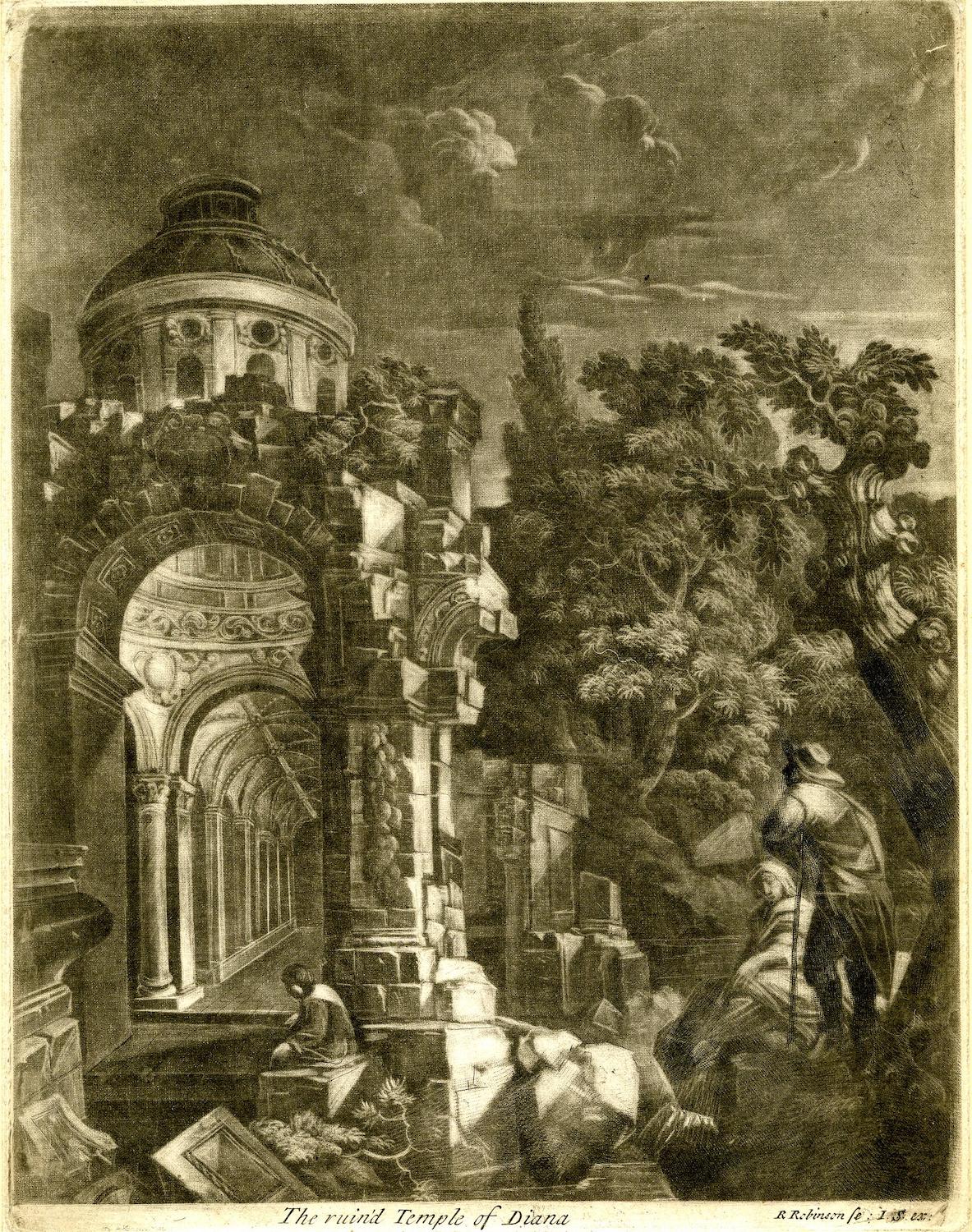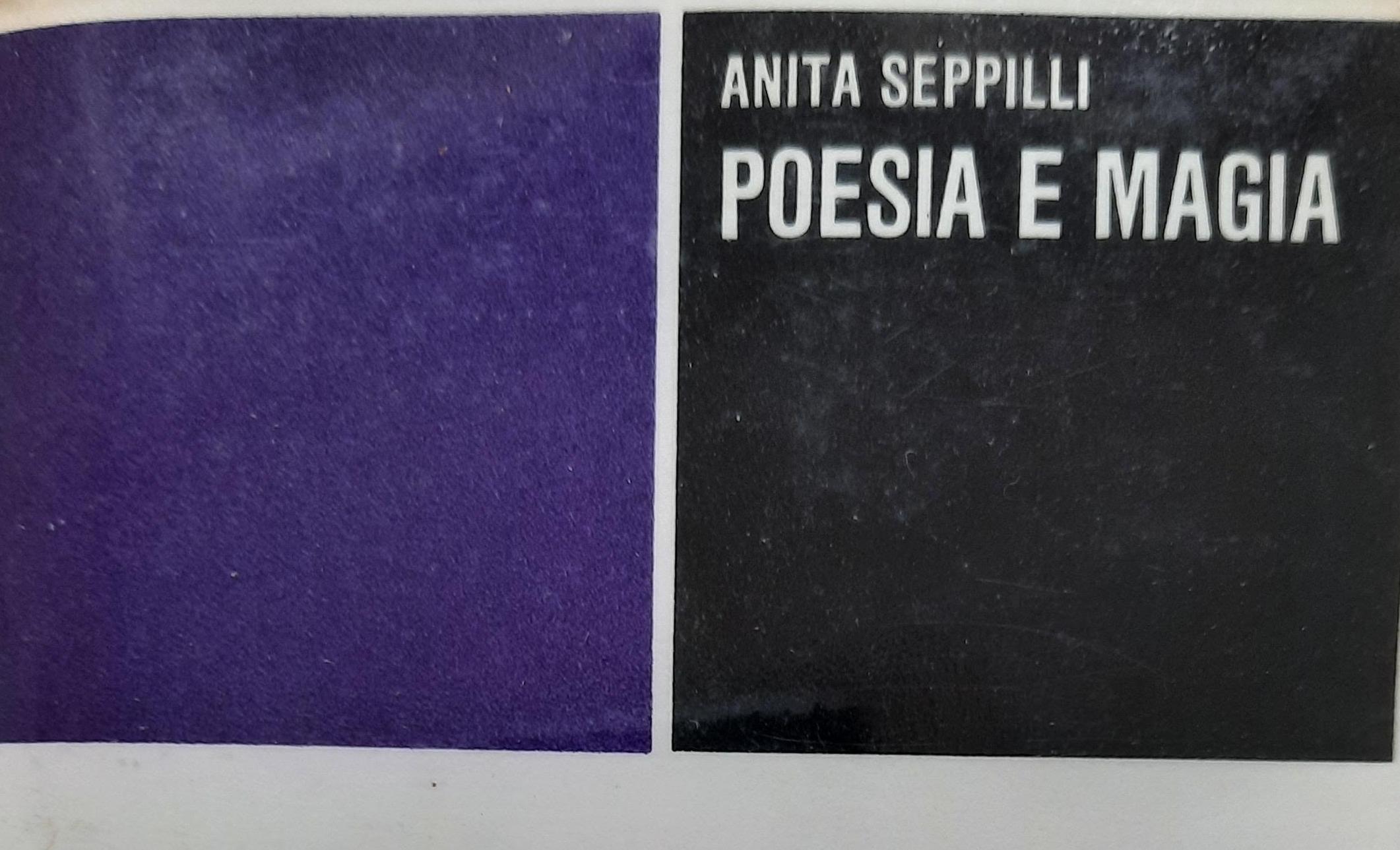Robert Robinson, The Ruined Temple of Diana, 1680-90, mezzotint.
Inscription: ‘The ruin’d Temple of Diana / R Robinson fe: I. S. ex:’

Robert Robinson (active 1674 – died 1706) was a decorative painter, often employed to produce backdrops for the theatre. He was a member of the traditional painter’s guild in London, the Painter-Stainer’s Company, and is documented in 1684 as having been assaulted by a ‘Mr Kneller’ during a search of premises to inspect the quality of work on the company’s behalf – although it is not clear that this was the artist Godfrey Kneller.[1] In spite of the fact that few of the prints that Robinson produced are signed, it proved possible for James Ganz to put together his oeuvre on the basis of his distinctive and vigorous mezzotint technique.[2] Robinson is one of the more interesting minor artistic figures from the late Seventeenth Century, judging by the range of prints after his own inventions, including some striking still-lives, and this print of The Ruined Temple of Diana (a pair to The Ruined Temple of Apollo), which has been described by Richard Godfrey as having ‘an evocative and romantic quality quite foreign to English art at this period’.[3] Perhaps in designing it Robinson was aware of the legend perpetuated by the antiquarian William Camden that St. Paul’s Cathedral in London was built on the site of the Roman temple of Diana?[4] The impression exhibited here was published by the famous and prolific mezzotinter John Smith and bears his ‘excudit’.
The site of abandoned and forgotten rites, the ruined temple poses an enigma within the wooded landscape in which it is situated. Three figures, two seated and one leaning against a staff, appear to have caught the pensive even oneiric mood suggested by the evocative remains. Are they travellers or perhaps shepherds? Poets even? The thinker to the left is sitting in such a way that his profile is framed by the archway opening on to the steep perspective created by the receding bays of a cloister. His thoughts appear to be drawn backwards in time as well as space by this device. The other two figures, one of whom is draped and may be a woman, or perhaps a philosopher, are silhouetted against twisting branches and lush foliage: a natural profusion that contrasts with the architectural regularity of the temple’s interior. This suggestive juxtaposition could represent a form of psychomachia, or internal conflict between reason and imagination.[5]
Robinson’s print has been included in this exhibition because it can be interpreted as illustrating Anita Seppilli’s fundamental argument that the poetic mode of thought which, through the associative processes of metaphor and metonymy, creates images that express psychological and emotional truths, has its origins in the myths, rituals and magical practices that once endowed the cosmos with meaning and forged the identities of social groups. More particularly, the mystery of the abandoned temple speaks to the role of enigmas or secrets as analysed by Seppilli, although in this case the Temple of Diana proves enigmatic because the loss of the knowledge of its original function has rendered the partial clue of the ruins unintelligible to later observers. Seppilli discussed the prophetic if obscure language of Cassandra at Troy, the ‘kennings’ of Norse poetry, and the role of secrecy in the Eleusinian Mysteries as examples of enigmas. Dead souls would be posed with a riddle by the god Thoth, or so the Egyptians believed, to which the correct answer, and key to the afterlife, was ‘Osiris’. This was the ultimate form of initiation. ‘The obscure metaphors and enigmas with which the prophecies were filled were anything but a game’, Seppilli wrote, ‘they had to be understood and solved for the salvation of men or states. In posing and resolving them lay the whole science of divination’ [Le oscure metafore e gli enigmi di cui eran colmi i vaticini eran tutt’altro che un gioco, essi dovevano venir intesi e risolti per la salvezza degli uomini o degli stati. Nel porli e risolverli, nell’indovinarli, stave tutta la scienza della divinazione].[6]
Here the ability to solve riddles was seen by Seppilli as analogous to the belief in magic. This was because both processes are based on the equation that knowledge equals power (‘conoscenza – potenza’). ‘Only when the enigma, or rather, that ideational process which is its basis, ceases to be understood, partially or completely, as knowledge of the divine, did it begin to “decay” into free art, into the prompt or theme for a fairy tale, becoming folklore, and thereby surviving for centuries and centuries in a long twilight, the long twilight of the vital forces of the spirit, which have lost a certain essential reason for existence. Myth decayed too in the same way’ [Solo quando l’enigma, o meglio, quell processo ideativo che sta alla sua base, cessò di essere inteso in parte, o totalmente, come conoscenza del divino, esso incominciò a “decadere” ad arte libera, a spunto o tema di racconto favolistico, divenne folclore, e cosi sopravvisse per secoli e secoli in un lungo crepuscolo, il lungo crepuscolo delle forze vitali dello spirito, che abbiano perduta una certa ragione essenziale di esistenza. Alla stessa maniera decadeva il mito].[7]

Interestingly, Seppilli referred to the legendary stories of the Queen of Sheba visiting King Solomon in order to test his ability to solve riddles: ‘the famed wisdom of Solomon is linked in folklore to the ability to pose and solve riddles’ [la fama di Sapienza di Somone è legata, nel folclore, alla capacità di pore e di risolvere enigmi].[8] This tale is retold by Marcelle Hanselaar in one of her works included in this exhibition. As Mark Golder has pointed out, Hanselaar seizes on the detail of Sheba’s hairy legs, revealed to Solomon’s critical gaze when the queen lifted her skirts to keep them dry on mistaking a glass floor for a pool of water (this story is derived from the midrashic Targum Sheni and it expands significantly the terse Biblical account).[9] The title of Hanselaar’s print is ‘The Secret’ and her interpretation certainly restores dark mystery to the folk tale, while also turning the tables on Solomon who is reduced to a shadowy figure shrinking in awe from Sheba’s revelation.
[1] Antony Griffiths with Robert A. Gerard, The Print in Stuart Britain 1603-89, exhibition catalogue, London: British Museum Press, 1998, pp. 256-8; Timothy Clayton, The English Print 1688-1802, New Haven and London: Yale University Press, 1997, p. 58.
[2] James Ganz, Fancy Pieces: Genre Mezzotints by Robert Robinson and His Contemporaries, exhibition catalogue, New Haven: Yale Center for British Art, 1994.
[3] Richard Godfrey, Printmaking in Britain, Oxford: Phaidon, 1978, p. 29.
[4] William Camden, Britannia, 1607, pp. 306-7. Camden also suggested that the name ‘London’ might derive etymologically from the Brythonic words for ‘grove’ and ‘town’. Other etymological explanations have suggested that London means ‘city of the moon’ or even ‘temple of Diana’; John Stow, A Survey of London Written in the Year 1598, Stroud: The History Press, 2009, p. 285: ‘Some have noted, that in digging the foundation of this new work, namely of a chapel on the south side of Paul’s Church, there were found more than a hundred scalps of oxen or kine, in the year 1316. Which thing, they say, confirmed greatly the opinion of those which have reported, that of old time there had been a temple of Jupiter, and that there was daily sacrifice of beasts. Othersome, both wise and learned, have thought the buck’s head, borne before the procession of Paul’s on St. Paul’s day, to signify the like.’ Stow then goes on to relate the remarkably pagan ceremony of the buck’s head being borne on a pole before the cross from the high altar (although he claims this ritual derived from the payment of feudal dues on land in Essex and not from the ancient worship of the moon goddess).
[5] The architectural ruins are reminiscent of the woodcuts in Francesco Colonna’s Hypnerotomachia Poliphili, Venice: Aldus Manutius,1499 (the partial translation in English, The Strife of Love in a Dream, was published in London in 1592 by R. D.).
[6] Anita Seppilli, Poesia e magia, Torino: Einaudi, 1971, p. 302.
[7] Ibid, p. 307.
[8] Ibid, pp. 302-3.
[9] Mark Golder in Marcelle Hanselaar, Rebel Women from the Apocrypha, London: Julian Page, 2023.
